March 30, 2011
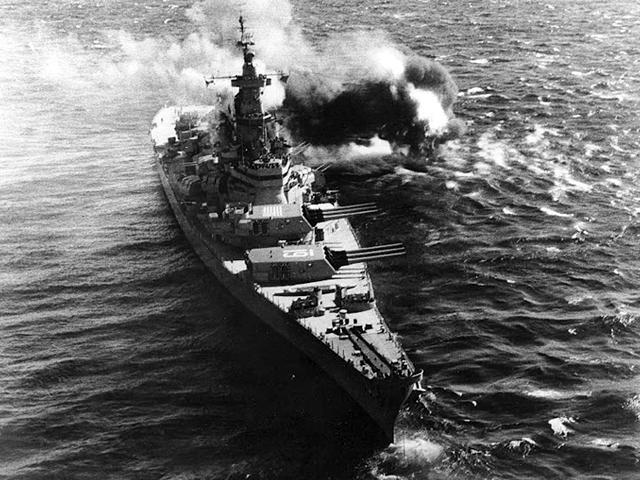
The USS Iowa was the namesake for what was arguably the best class of battleships ever built. Launched in 1942, she was commissioned in 1943. Displacing 45000 tons, her engine rooms could still move her through the water at a blistering 33kts. Her main armor belt was 12" thick, while her three main turrets were armored to nearly 20" in thickness. Those turrets carried three 16"/50cal rifles each, and each of those guns could fire a 2700lb shell over 23 miles. Twenty 5"/38cal guns formed her secondary battery, and could be used for both anti-aircraft or anti-surface work. Four of the mammoth warships were built.
But only one had a bathtub.
Late in 1943, the heads of state for the three major Allied countries, Joseph Stalin, Winston Churchill and Franklin D Roosevelt, were to meet in Tehran for a strategy conference. The US Navy choose the USS Iowa to take President Roosevelt on the first leg of the journey to Iran, crossing the Atlantic Ocean. But there was a small snag. President Roosevelt had developed an illness in 1921, at the time diagnosed as polio, that had paralyzed him from the waist down. He could only walk by swinging his legs laboriously via a twist of his torso, and leg braces and crutches were mandatory. FDR was also pretty much incapable of standing without assistance from one or two individuals. This ruled out his use of a shower, at the time the only form of bathing available on US warships. As the trip would take quite some time, something had to be installed for his use. That something was Iowa's Bathtub.

Who knew?
Posted by: Wonderduck at
08:02 PM
| Comments (8)
| Add Comment
Post contains 275 words, total size 2 kb.
March 27, 2011
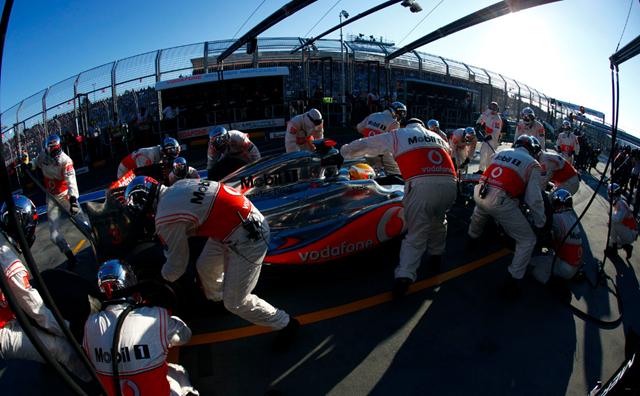
All right, here's how this is going to work. The F1Update! for the Grand Prix of Australia will go up this evening. The writeup for Rio Rainbow Gate! Episode 12 will be up on Monday.
Ph.Duck has returned to Duckford after his two weeks in India. Between watching the race last night and getting up on (mutters quiet obscenities) hours of sleep to get him back home after his 17.5 hour flight afterwards, all of which came on the heels of my Fantasy Baseball League auction (and quals earlier) on Saturday, your host is very tired, very headachy, and just not up to writing right now.
So I'm going to take a nap. THEN I'll start writing.
Posted by: Wonderduck at
11:37 AM
| No Comments
| Add Comment
Post contains 120 words, total size 1 kb.
March 16, 2011
Of course, we remember Midway as the namesake location of one of the most important battles of any sort in history. One aspect of Midway atoll that seemingly every history of the Battle remarks upon are the ubiquitous avian residents, the Laysan Albatross.

Better known as the Gooney Bird for their goofy, clumsy appearance on land, nearly a million of these birds live on Midway today, and there's no reason to think any fewer were there during WWII. Gooneys are known to have extremely long lives, with the oldest known to be over 60 years old, and possibly older. It's quite possible that some Gooneys alive today were present on Midway during the battle.
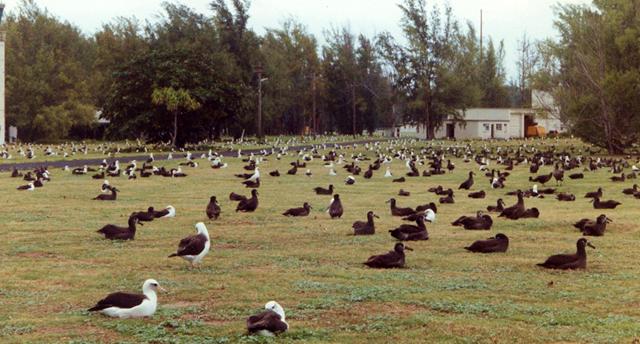
Lost among the tragic news reports coming out of Japan in the wake of the magnitude 9.0 earthquake and huge tsunami that followed it, were bulletins from Midway atoll. Sand Island, the largest of the islands that make up Midway, was 20% covered by water from the tsunami's five foot tall waves, while Eastern Island had been 60% covered. Spit Islet, the largest of the minor land masses that make up the atoll, was completely inundated. As a result of this, over a thousand adult Gooney birds were killed, and many thousands of flightless chicks were drowned as well. "We may see just a slight decline in breeding birds next year, next year and the year after that," said Barry Stieglitz, project leader for the Hawaiian and Pacific Islands National Wildlife Refuges. "There will be a gap in the breeding population when these birds that would have grown up this year, would have matured and started breeding for the first time."

Posted by: Wonderduck at
09:46 PM
| Comments (2)
| Add Comment
Post contains 374 words, total size 3 kb.
March 15, 2011
By 1906 though, the Japanese fleet was made obsolete by the appearance of HMS Dreadnought in the British Royal Navy. Realizing that evolving technology had laid their fleet to waste (and terrified by that fact), the IJN made plans for a new and improved fleet of ships. Called the "Eight-Eight Fleet", it was to be based around eight new Dreadnought-style battleships and eight cruisers. Designed to be capable of going toe-to-toe with the US Navy, even at this early date thought to be Japan's most likely foe, this battleline was considered the only way the nation of Japan could be made safe. Though the country had been practically bankrupted by its war with the Russians, the first batch of ships was approved in 1911.
Events on the other side of the world again worked against the IJN's plans. While Japan had sided with the Allies in World War I, for all intents and purposes she had little to do with the European theater of war. Instead, she had little spats with far-flung German possessions in the Pacific. Meanwhile, the war in the Atlantic led to massive improvements in naval technologies for the combatants there. Suddenly, the IJN again found themselves with seemingly obsolescent ships while their rivals had honed their fleets against the whetstone of war.
The decision was made to scrap the first Eight-Eight fleet plans and start a second. This second fleet was to be built around a nucleus of the newest vessels of the first, two completed battleships of the Nagato-class, two Tosa-class battleships that were in the process of being built, and four Amagi-class battlecruisers that were in various stages of construction. They were to be joined by four battleships of an unnamed class that was to carry 18" guns, and four "fast battleships" to accompany the battlecruisers.
The Amagi-class was to tip the scales at over 41000 tons, be capable of 30kts, and carry ten 16" guns on a hull some 826 feet long. As with all battlecruisers, the Amagis were not particularly well-armored; they were designed to be able to outgun anything they could outrun (cruisers of all sizes and destroyers), and outrun anything that outgunned them (battleships, mostly). While in retrospect it's clear that the battlecruiser concept was deeply flawed, the thinking of the time was that speed, not armor plating, would be a battlecruiser's best defense.
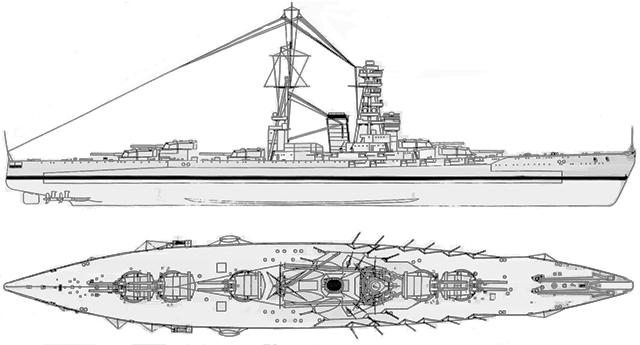
In 1922, the IJN's plans again had to be scrapped when Japan became a signatory to the Washington Naval Treaty. This attempt to curtail the growing naval arms race ongoing between Britain, America, Japan, France and Italy placed an upper limit on the size of any ship built of 35000 tons. All work on the four battlecruisers and two battleships came to a halt, in preparation for scrapping. With the stroke of a pen, both the Amagi-class and the Tosa-class, like the British N3 and G3 designs, had been invalidated.
Or almost so. The Treaty placed an upper limit on the size of aircraft carriers of 27000 tons. However, a provision of the treaty, insisted upon by both the Americans and the Japanese, allowed for the conversion of two ships of a maximum weight of 33000 tons each to aircraft carriers. The US Navy selected two Lexington-class battlecruisers for conversion. The IJN chose two of their Amagis, the namesake of the class and the Akagi, to be subjects for their conversions. The remaining battlecruisers were broken up and scrapped.
And then nature stepped in.
more...
Posted by: Wonderduck at
12:40 AM
| Comments (2)
| Add Comment
Post contains 1528 words, total size 12 kb.
March 14, 2011

I'm somewhat put out by this.
Posted by: Wonderduck at
09:29 PM
| Comments (2)
| Add Comment
Post contains 29 words, total size 1 kb.
March 07, 2011

The great reveal of the secret from a few days ago. When I saw these, I knew they had to join The Flock. Some things are too good not to own. Even better, I hear tell that they're going to be appearing over at Quacked Panes sometime in the near future, too!
Oh, the title of this post?
Only Daft Punk could make a song with only two words sound so darn cool...
And yes, that is my dead video card glowing ominously in the background...
Posted by: Wonderduck at
07:34 PM
| Comments (2)
| Add Comment
Post contains 97 words, total size 1 kb.
March 04, 2011
During the Allied invasion of Sicily, there was a need for artillery spotting airplanes. The usual plane used, the L-4 Grasshopper (better known in civilian use as the famous Piper Cub), didn't have the range to actually fly to Sicily from Allied bases, and aircraft carriers decks were too valuable to ferry them there. Having them transported in a knocked-down state was possible, but it was time-consuming to have to put them back together. Knowing all this, a US Army pilot named Captain Brenton Devol, suggested a solution: put a flight deck on a LST. And lo, was the tiniest aircraft carrier created.
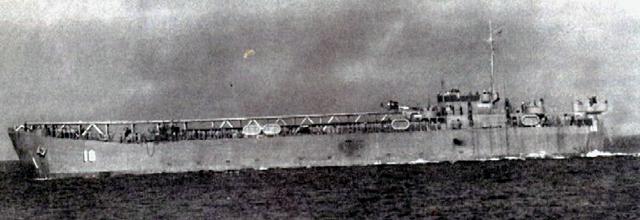
LST-386 was fitted with a flight deck made of timber and pierced metal runway mats. It measured 216 feet long by 12 feet wide, and it took just over 36 hours to build. It could carry four Grasshoppers, plus its normal load of cargo and troops in her tank deck.
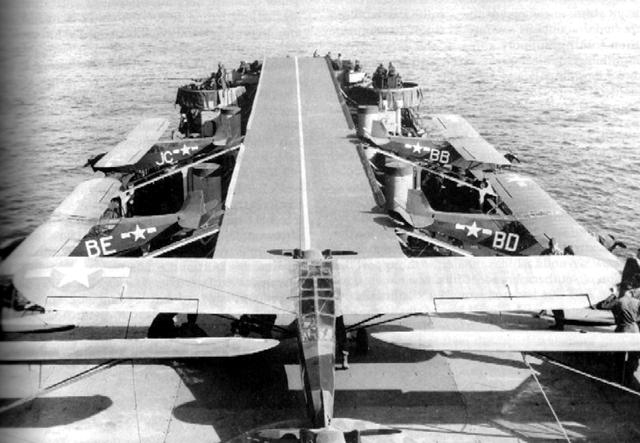
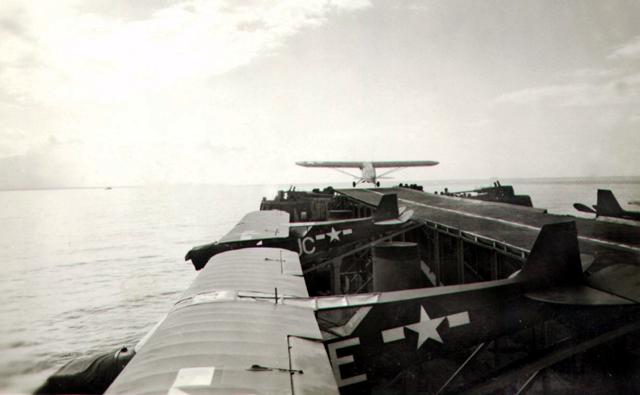
However, these LST conversions could not be considered true aircraft carriers. There was no provision for recovering the L-4s after launch; the planes would have to land behind friendly lines after takeoff. Considering the short-field capabilities of the Piper Cub, one could imagine a scenario where the LST would steam backwards while a white-knuckled pilot tried to land on the narrow pitching deck. It could work, but it seems unlikely.
But out in the Pacific theatre, something different was invented... something that was allowed a LST to become a true aircraft carrier. This something was called the Brodie Device.
more...
Posted by: Wonderduck at
11:54 PM
| Comments (5)
| Add Comment
Post contains 799 words, total size 6 kb.
March 02, 2011

Well, crap. That's a dead graphics card, sure as god made little green martians. Obviously, I was going to have to remove that dying card (nearly five years old)... but while I installed the card in the first place, I've never removed a graphics card. I didn't know what I was going to have to do... just yank it out and plug the monitor into the onboard graphics adapter? Remove the drivers? Boil water and tear bedsheets?
Once I got to the Duck U Bookstore, a quick googlesearch turned up diddly. The question may as well have never been asked before. So I shot an e-mail to friend GreyDuck, a computer guy of some repute, asking for help (or as I put it, "HALP!!!"), and he responded with flying colors. A phone call from The Boss's husband also steered me in the right direction... just pull the card out and cross your fingers.
One broken PCIx16 retention clip later, the card was out and I was running on glorious onboard graphics... and I discovered something I had forgotten. Namely, onboard graphics are crepe on a stick, particularly when mated to a LCD monitor that doesn't run at one of the available resolutions. I can only just barely run a anime mkv (12 frames a second, maybe?)... which means I need to get a new GPU as soon as I can.
But at least Chiyo-chan works again. That's the main thing. So thanks, GreyDuck and Boss's Husband! Much appreciated, both of you!
UPDATE: There's this thing that you can do with a computer called "restart." Perhaps you've heard of it? It shuts down the computer then gets it running again... including such things like your graphics card drivers that allow you to set the resolution to something that doesn't make your eyes bleed. It also installs D3DX9, which allows you to actually watch things larger than 1mb in size. Useful thing, that. It also means that, unless I suddenly have this burning need to play Fallout 3, I can live without a GPU until I actually have a modicum of funds. Pity I didn't think about this whole restart thing sooner, my eyes might not have fallen out.
Posted by: Wonderduck at
08:27 PM
| Comments (4)
| Add Comment
Post contains 432 words, total size 3 kb.
51 queries taking 0.2375 seconds, 312 records returned.
Powered by Minx 1.1.6c-pink.









